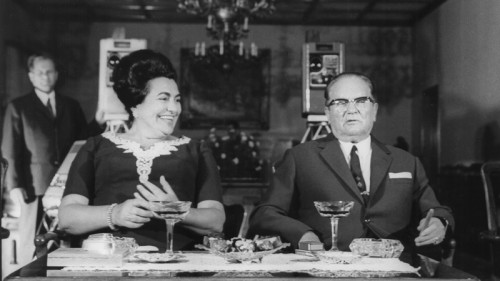Cinema Komunisto was screened as part of the United Nations Annual Film Festival (UNAFF) which is now in its 14th year and continues until Oct 30th. See the full roster of films at http://www.unaff.org.
Knowing that Cinema Komunisto was about the Yugoslav film industry, I had to try hard to suppress a groan as the film opened with the line “This is a story about a country that-,” suspecting that it would end with “doesn’t exist anymore” and would expand into a feature-length forced march down the nostalgic road. Thankfully, as brief clips of Yugoslav filmmakers’ successes rolled, the fragmented sentence ended “-that exists only in films.” It set the stage for an insightful look into how tightly cinema was sown into not only the Communist identity of the Second Yugoslav republic, but its very existence.
We hear about Communists hijacking the various forms of cultural production to the point of banality – ironically, the various Parties’ propaganda has such reach in the post-Cold War era that its distinctive poster style is itself appropriated for commercial purposes and the early propaganda films (particularly Chinese ones) are shown as entertainment in Political Science classes. However, none of this exposure has done anything more than graze the surface of the significance of the arts, and in particular film, to socialism.
Yugoslavia is a case in point. The birth of the cinema industry – a rapid construction project based on mass mobilisation of zealous youthful volunteers – occurred at the same time and in the same manner as the reconstruction of the Yugoslav republic itself in the immediate aftermath of World War II. The war had given birth to conjoined twins, who as it turned out, were never to be separated. The connection between the two in the Yugoslav case was inextricable and based on far more than state-owned production companies churning out gloriously gory tales of the partisan struggle that begat their nation, even if that was how things started – hundreds upon hundreds of films where hundreds upon hundreds of Nazis had holes punched in them by strikingly beautiful female snipers and machine-gunners who had never before touched a gun.
The big link between the two was of course The Big Man in Yugoslavia, Josip Broz Tito. His love of cinema was, to put it lightly, rabid. He almost invariably watched a film every night, adding up to 8,801 films watched from his thirty-plus years in power. In 1957, he actually managed to watch 365 films in 365 days. On the one occasion that his scrambling assistants ended up bringing him a film he had previously seen, he called them out during the opening credits and pinpointed the day it had been watched five years before. Because The Big Man loved cinema, the Yugoslav people were encouraged to love cinema, much like how the Chinese now love ping-pong because Mao loved ping-pong. At the Roman Theatre in Pula, Croatia, from the sixties onwards screenings happened every night to a staggering audience of ten to fifteen thousand. Ratko Drazevic, the man who took the reins of the state-owned film studio Avala, the largest in Europe, was a former State security officer. The string of Hollywood blockbusters that were filmed in the diverse and picturesque Yugoslav landscape, including Marco Polo, brought in valuable foreign currency into the country at a time when it was running short.
Being as dependent as it was on the generous support of the state, the Yugoslav cinema industry wilted when the state fragmented. The documentary plays with this fall from greatness and its accompanying nostalgia, skipping back and forth between the Tito-era and the present. Like other socialist regimes, Tito’s lauded youthfulness and energy because they were extensions of the great love of socialism – the future. Director Mila Turajlic emphasises this with the selection of triumphant scenes of battle, the grand scale of the productions organised by the expert Yugoslav set designers, and the always-charming music that seemed to be Communist chants superimposed on Western music of every genre. In stark contrast, the scenes from the present are of once-young men revisiting buildings destroyed by the NATO bombings, or the ivy-covered skeleton of the Avala studio, or standing with larger-than-life statues of Tito in the positions they used to stand.
The nostalgia is powerful and moving, but so substantive that it never feels overdone. Maybe its substance comes from the fact that as the opening line of the film suggests, unlike the ideals, and people, and giant factories that disappear with the end of a regime, Yugoslavia will continue to exist forever in films.
Ollie Khakwani (’13, STS – Product and Interaction Design / minors in Political Science and Art Practice) was the editor of the Design section and Managing Editor of the Stanford Arts Review. In his spare time he likes playing the drums, hating on Proust, and making stuff out of garbage and garbage out of stuff. Check out his work at http://www.olliekhakwani.com.

